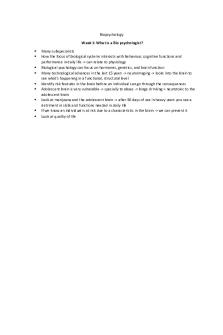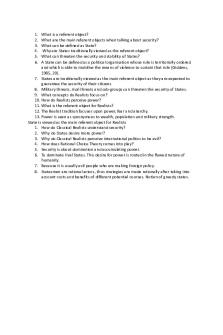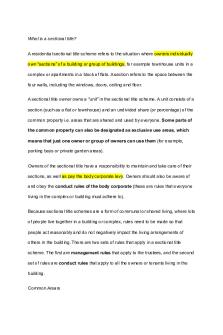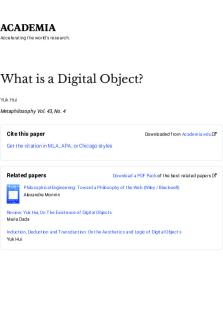What is a ketogenic diet PDF

| Title | What is a ketogenic diet |
|---|---|
| Course | Química Biológica |
| Institution | Universidad de Monterrey |
| Pages | 2 |
| File Size | 117.4 KB |
| File Type | |
| Total Downloads | 87 |
| Total Views | 141 |
Summary
tarea sobre la dieta keto ...
Description
what is a ketogenic diet? A ketogenic diet is a low carbohydrate very high-fat diet what's the origin of the ketogenic diet? where does it come from? who created it? 400 bc Physicians of ancient Greece treated diseases by changing the patient's diet 1911 in France patients with epilepsy were treated by detoxifying them with a low-calorie vegetarian diet combined with periods of fasting and purging. around this time Dr. Hugh William Conklin began to treat his patients that had epilepsy with a water diet and fasting, he was successful in almost 90% of his pediatric cases. 1916 Dr. McMurray treated his epileptic patients with a fast followed by starch and sugar-free diet 1921 Dr. Rollin Woodyatt noted that three water-soluble compounds were produced in the liver as a product of starvation or if they follow a diet rich in fat and low in carbohydrates 1921 Russell Wilder called it Ketogenic diet and also used it as a treatment for epilepsy 1971 Peter Huttenlocher devised a ketogenic diet where 60% of it was composed of MCT oil which led to parents to prepare richer in protein and enjoyable foods for their kids
what is the biochemical principle of the ketogenic diet? explain all metabolic pathways involved carbohydrates are the primary source of energy production in tissues when the body is cut off from carbs or has an intake of fewer than 50 grams per day, insulin secretion is decreased and the body enters a catabolic state. gluconeogenesis is the metabolic pathway that results in the generation of glucose so when the body is not generating enough glucose this is not able to keep up with the needs of the body and the body enters ketogenesis in order to provide an alternate source of energy in form of ketone bodies. during ketosis the insulin output is low which reduces the stimulus for fat and glucose storage, more hormonal changes happen in ketosis that contributes to the breakdown of fat, fatty acids are metabolized to acetoacetate that is converted into beta-hydroxybutyrate and acetone which are called ketone bodies. acetoacetate and d-3 hydroxybutyrate are interconverted in the mitochondria. in mammals, the liver is the only organ that significantly produces ketone bodies and they are continuously flowing from the liver to the extrahepatic tissues. acetylCoA forms when 2 molecules of acetyl CoA condense or by terminal 4 carbon of fatty acids during B oxidation. condensation of acetoacetyl CoA with another acetyl CoA molecule by HMG CoA synthase forms HMG CoA, then HMG CoA lyase cause acetyl CoA to split off leaving acetoacetate. how does a ketogenic diet achieve weight loss? the ketogenic diet forces your body to use different sources of fuel within your body and it relies on the liver to break down stored fat into molecules called ketones...
Similar Free PDFs

What is a ketogenic diet
- 2 Pages

Ketogenic Diet Food List
- 12 Pages

Ketogenic diet essay
- 6 Pages

What is the Lemon Detox Diet
- 3 Pages

What is a Biopsychologist
- 1 Pages

What is a referent object
- 1 Pages

What is a social fact
- 2 Pages

What is ABA - Grade: A
- 5 Pages

What is race - Grade: A
- 1 Pages

What is a sectional title
- 4 Pages

What is a summary judgement
- 5 Pages

What is a product - lecture
- 4 Pages

What is a Digital Object?
- 17 Pages

What is a listing paragraph
- 14 Pages

What is a Breadth Indicator
- 4 Pages
Popular Institutions
- Tinajero National High School - Annex
- Politeknik Caltex Riau
- Yokohama City University
- SGT University
- University of Al-Qadisiyah
- Divine Word College of Vigan
- Techniek College Rotterdam
- Universidade de Santiago
- Universiti Teknologi MARA Cawangan Johor Kampus Pasir Gudang
- Poltekkes Kemenkes Yogyakarta
- Baguio City National High School
- Colegio san marcos
- preparatoria uno
- Centro de Bachillerato Tecnológico Industrial y de Servicios No. 107
- Dalian Maritime University
- Quang Trung Secondary School
- Colegio Tecnológico en Informática
- Corporación Regional de Educación Superior
- Grupo CEDVA
- Dar Al Uloom University
- Centro de Estudios Preuniversitarios de la Universidad Nacional de Ingeniería
- 上智大学
- Aakash International School, Nuna Majara
- San Felipe Neri Catholic School
- Kang Chiao International School - New Taipei City
- Misamis Occidental National High School
- Institución Educativa Escuela Normal Juan Ladrilleros
- Kolehiyo ng Pantukan
- Batanes State College
- Instituto Continental
- Sekolah Menengah Kejuruan Kesehatan Kaltara (Tarakan)
- Colegio de La Inmaculada Concepcion - Cebu
